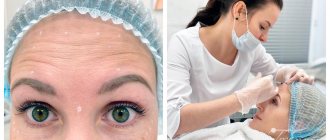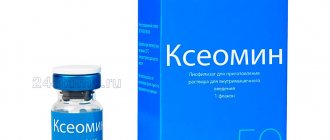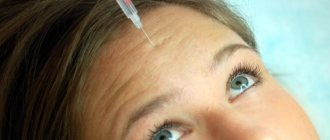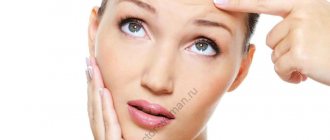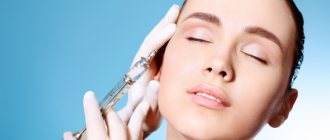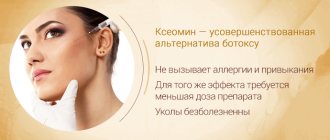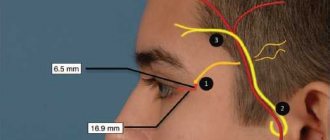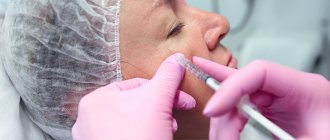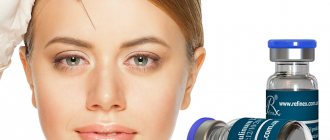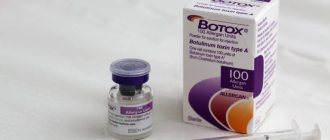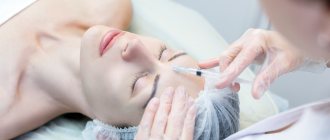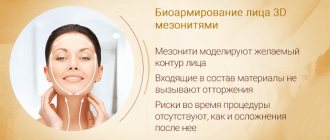- Botulinum toxin Botox (Botox)
- What happens after the procedure
- Video about how the drug works
- Botulinum toxin injections in the forehead
- Injections into the armpits
- The Myth of Botox
- The most common areas for Botox injections
- Photos before and after the procedure
- Prices
- Reviews from cosmetologists
Botulinum toxin Botox is a well-known drug based on botulinum toxin, which has been used in cosmetology for many years. The manufacturer of the drug Botox is the pharmaceutical company Allergan (USA). It is used to eliminate facial wrinkles in the area between the eyebrows, forehead, and area around the eyes (“crow’s feet”). The drug has been used in medicine since 1988, during which time the drug has conquered the world and proven its safety and effectiveness.
What happens after the procedure
After Botox injections, facial muscles relax and, as a result, wrinkles smooth out. The effect of one procedure lasts from 3 to 9 months, after which it can be repeated. The duration of the effect depends on the dose of the drug, the characteristics of the body, and lifestyle.
Botulinum toxin - its injections not only “remove” wrinkles, but also serve as a good prophylactic agent for active facial expressions. This procedure will easily wean you from frowning and, ultimately, will help keep your skin smooth for a long time.
The injections themselves are well tolerated and do not require special preparation. Immediately after the procedure, you can return to your normal activities.
Possible side effects
Complications occur when the cosmetologist’s recommendations are not followed or when the dosage of the drug is incorrectly calculated.
Side effects:
- Swelling. Most likely to occur in people with vascular diseases, hormonal imbalances and alcoholism. Often the swelling goes away on its own after a few days. If the swelling does not go away, you need to contact a cosmetologist again.
- Facial asymmetry. If the drug spreads beyond the target zone, asymmetry appears. In this case, it is often impossible to correct the shape of the face; you should wait until the botulism is eliminated by the lymphatic system. Additional injections for correction may worsen the problem.
- Articulation problems. They arise due to too much injected volume of the drug into the corners of the lips or into the muscles that control their movements. Possible drooling.
- Headache. This consequence is caused by overstraining some muscles while relaxing others or improper recovery after the procedure. In some patients, the headache persists for up to two weeks.
- Seals. If the drug is distributed unevenly, bumps appear under the skin. This occurs due to an excessive dose of the administered drug or an individual reaction. The seals can be corrected 2 weeks after the session.
Side effects that do not indicate problems are dizziness, a slight rise in temperature, nausea, and weakness. These unpleasant consequences will soon disappear.
A critical condition after botulinum toxin injections is indicated by numbness of the limbs and rapid heartbeat. If these signs are noticed, you should consult a doctor as soon as possible.
Botulinum toxin injections in the forehead
The appearance of wrinkles in the forehead area at the age of 35-45 years is a fairly typical development of the situation, due to a decrease in skin turgor and age-related changes. The most effective way to eliminate this deficiency is by local administration of drugs based on botulinum toxin. During the blocking of neuromuscular transmission, the transverse grooves formed by the contraction of the facial muscles straighten. The entire procedure takes just a few minutes, so it is usually performed without anesthesia.
Since as a result of the procedure neither the muscles nor the nerve fibers are affected, therefore after 4-6 months the condition returns to the original level, repeated administration is necessary. At the same time, the professionalism of a cosmetologist is not to immobilize the muscles, but only to relieve their increased tone. This approach further ensures natural facial expressions and eliminates the appearance of a mask-like face. The drugs used to achieve this effect are usually Botox or Dysport.
Make an appointment right now!
We have extensive experience and real results
Sign up
Main indications for botulinum therapy:
- involuntary contractions of facial muscles
- bruxism
- lagophthalmos
- multiple sclerosis
- spasticity of the limbs after head injuries
- muscular torticollis
- blepharospasm
- tension headaches
- migraine
- tremor
- strabismus
- trigeminal nerve dysfunction
- pain syndrome of neurological origin
- tics
Botulinum therapy after a stroke can successfully combat spasticity, so it is actively used for the rehabilitation of such patients. Treatment is carried out under myography control. This allows you to objectively evaluate the results obtained and, if necessary, adjust the dosage.
Botulinum toxin injections into the armpits
The ability to straighten wrinkles is not the only effect of topical use of botulinum toxin-based drugs. Botox or Dysport are also used in the treatment of hyperhidrosis, a condition marked by increased sweat production. In this case, the introduction of botulinum toxin and blocking neuromuscular transmission leads to the fact that the sweat gland significantly reduces its secretion. By injecting the drug into the armpit area, it is possible to get rid of not only the unpleasant odor, but also excess moisture for a long period of time, up to six months.
Sweating plays an important role in maintaining the body's water-salt balance and freeing it from waste products. When turning to such a procedure, specialists carefully study all the associated factors and causes of hyperhidrosis.
Attention: Botox injections can only be performed by a qualified specialist who has undergone appropriate training.
Don't put it off until tomorrow. Call us and sign up for the procedure today!
Mechanism of action
Botulinum toxin is a neurotoxin. It blocks the release of acetylcholine, which is involved in the transmission of nerve impulses at neuromuscular synapses. Thus, if the nervous system sends a signal to the muscles, it does not reach the point of application. Consequently, the muscle remains in a relaxed state. Local administration of the substance in small concentrations allows for relaxation of certain muscles. That is why botulinum therapy for spasticity can achieve a positive result.
The direct effect of botulinum toxin is to influence motor and parasympathetic nerve fibers. Acetylcholine is blocked and does not leave the presynaptic part of the neuron, so the transmission of nerve impulses becomes impossible. The introduction of Botox and other drugs into the muscle leads to a decrease in the cross-section of muscle fibers and the number of myofilaments. Thus, the volume and strength of the muscle decreases. This process is reversible.
BEFORE
AFTER
The indirect effect of the substance is also described. At the level of the central nervous system, botulinum toxin leads to inhibition of alpha motor neurons and normalizes reciprocal inhibition between antagonist muscles (flexors and extensors). This makes it possible to combat such phenomena as skeletal muscle dystonia.
The analgesic effect of drugs for botulinum therapy was also revealed. This property was discovered by accident when using the toxin for anti-aging purposes. Doctors noticed that botulinum therapy for migraines reduces the intensity of pain, so they began to actively study this property. To date, it has been proven that BTA has an analgesic effect for dystonia, spasticity, tension headaches, trismus, migraines, and chronic pelvic pain. This is explained by several theories. The first is decompression of pain receptors due to the elimination of muscle spasm. The second is the normalization of muscle spindle contraction. The third theory is a reduction in neurogenic inflammation.
Photos before and after the procedure
What result should I expect?
The effect after botulinum therapy can be assessed after 7-10 days. If the purpose of the session was rejuvenation, the patient will notice the smoothing of deep folds and the disappearance of fine wrinkles. When correcting the contours of the face, its oval becomes symmetrical and the lines become smooth. The effectiveness of botulinum therapy in neurology can be assessed using myography, as well as by the patient’s subjective feelings, the degree of restoration of lost functions, and a decrease in the intensity of pain.
The doctor will tell you what not to do after botulinum therapy. If you follow these recommendations, you can avoid complications. It is recommended to remain in an upright position for the first 4 hours after injections. This promotes uniform distribution of the drug and reduces the likelihood of swelling.
Should I try botulinum therapy?
If you have problems that can be solved by Botox injections, and there are no contraindications to the procedure, you should try this method. Is there any harm from botulinum therapy, is the toxin dangerous? This question worries many. The lethal dose of the toxin is more than 2 thousand units, and in medicine and cosmetology dosages are used that are at least 10-20 times less. This makes the development of dangerous complications completely impossible.
If you follow the recommendations after botulinum therapy, and don’t do what you shouldn’t do during the rehabilitation period, recovery will go quickly and without problems, and the result will live up to expectations.
Trust botulinum therapy only to professionals. The clinic of dermatocosmetology and endocrinology “Trinity” employs doctors with experience in performing the procedure, only high-quality drugs that have been officially registered are used, and anti-epidemic standards are observed. Thanks to an individual approach to each patient, doctors manage to achieve a pronounced effect after botulinum therapy, which will last for a long time.
Botulinum toxin injection is a well-studied, proven technique that is widely used throughout the world. If you decide to take a course in our clinic, you will be able to look attractive, feel confident, and also avoid complications after botulinum therapy thanks to the professionalism of the doctors.
The rehabilitation period after correction of wrinkles with botulinum toxin preparations
To eliminate the risk of complications and get the most pronounced results from the procedure, during the first days after the session you must follow a number of recommendations:
- If possible, limit sharp downward tilts of the head;
- do not take the “lying on your stomach” position in your sleep;
- exclude physical activity;
- refrain from visiting the bathhouse, sauna and solarium (up to 2 weeks);
- Do not use decorative cosmetics until the punctures are completely healed.
In addition, for 2 weeks you must refrain from taking antibiotics and other medications that can have a negative effect on the result of the procedure (the use of medications must be agreed with your doctor).
History of Botox
Bacteria that temporarily paralyze muscles (Clostridium botulinum) were discovered at the end of the 19th century, but more than 60 years passed before scientists came up with a rational use for them. In the late 1960s, Edward Shantz and Alan Scott began testing botulinum on monkeys. Later, this substance began to treat excessive sweating, strabismus, blepharospasm and achalasia of the esophagus.
In cosmetology, botulinum toxin began to be actively used at the turn of the 20th and 21st centuries. This happened after the discovery of ophthalmologist Jean Carruther: she noticed that under the influence of botulinum toxin, the orbicularis oculi muscle “crow’s feet” in the corners of the eyes noticeably contract.
